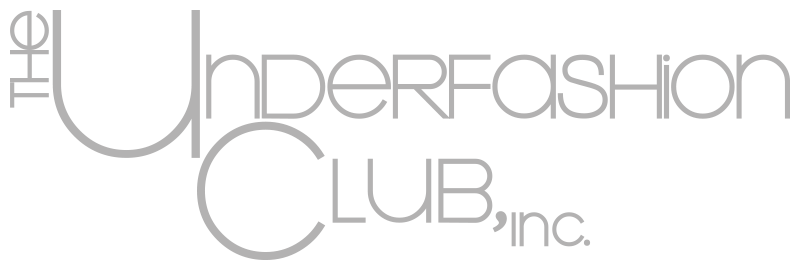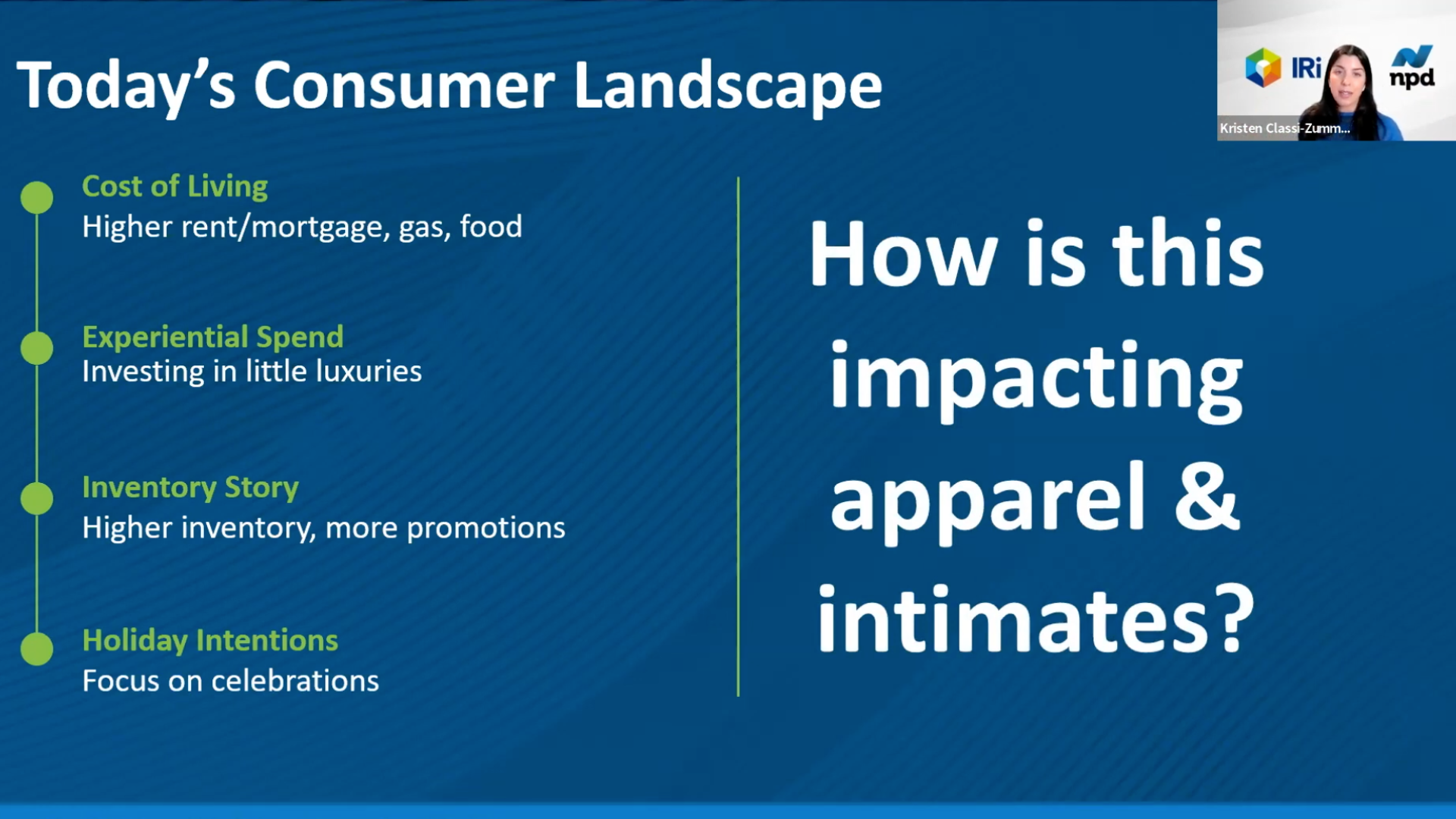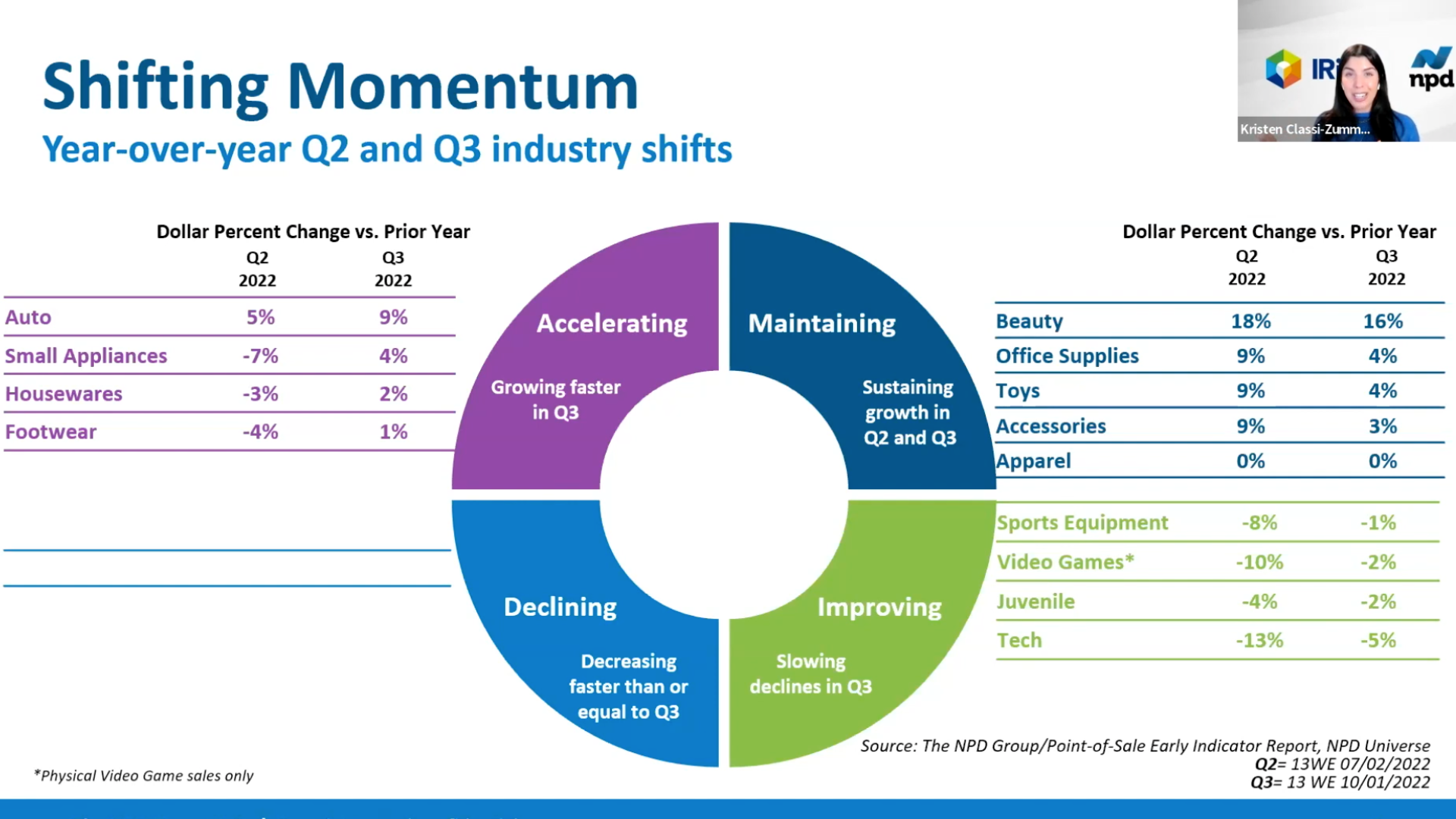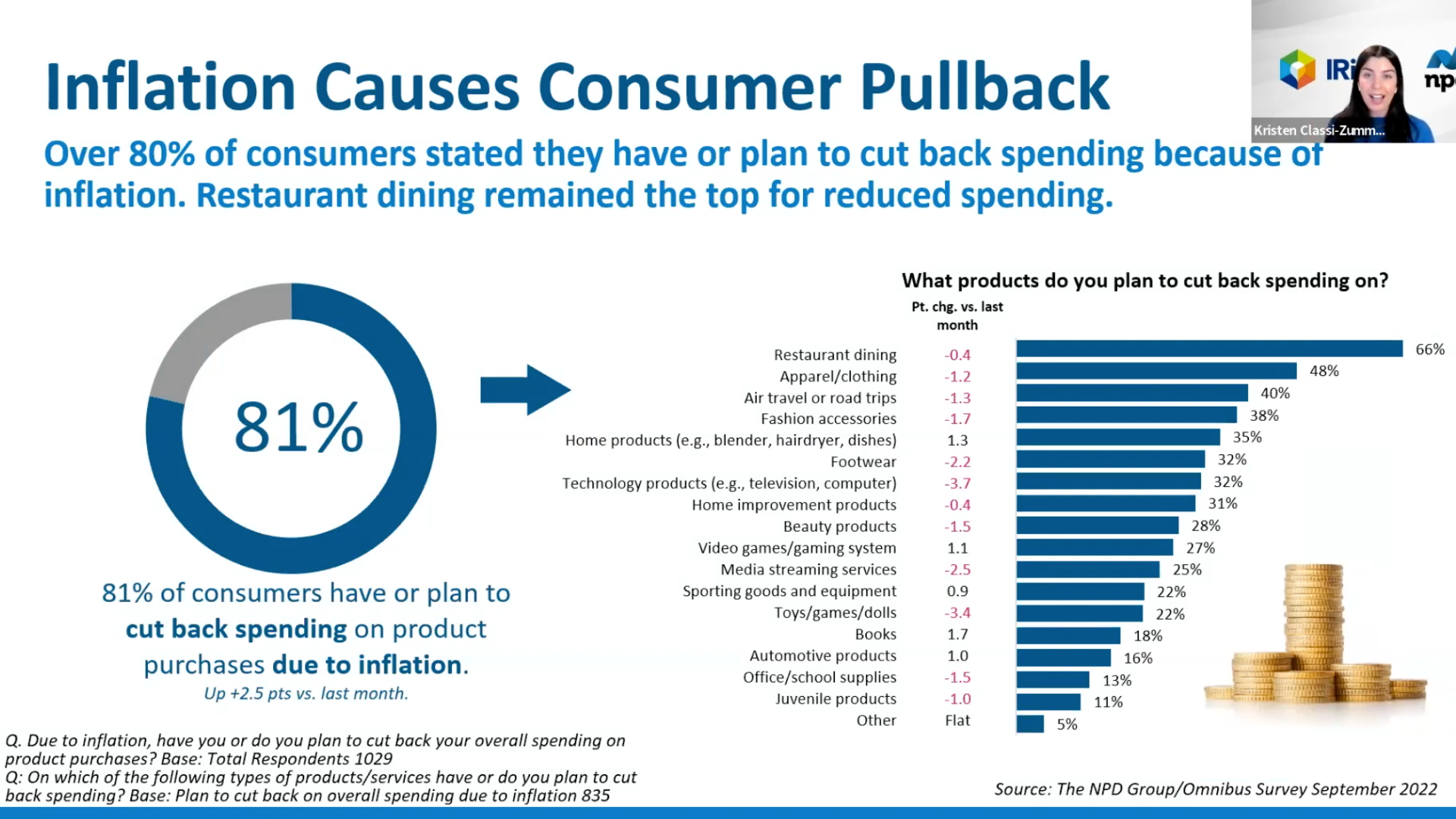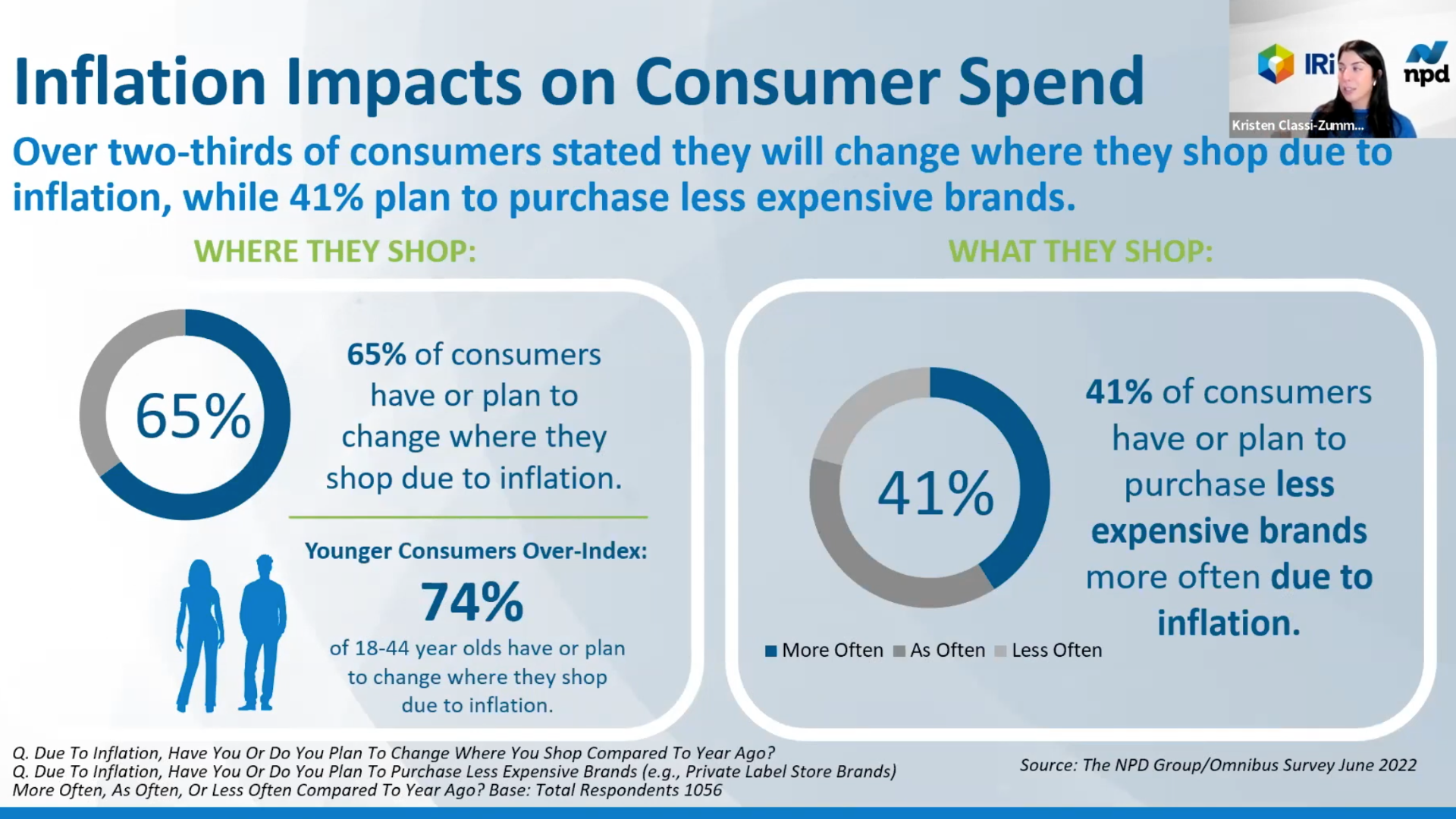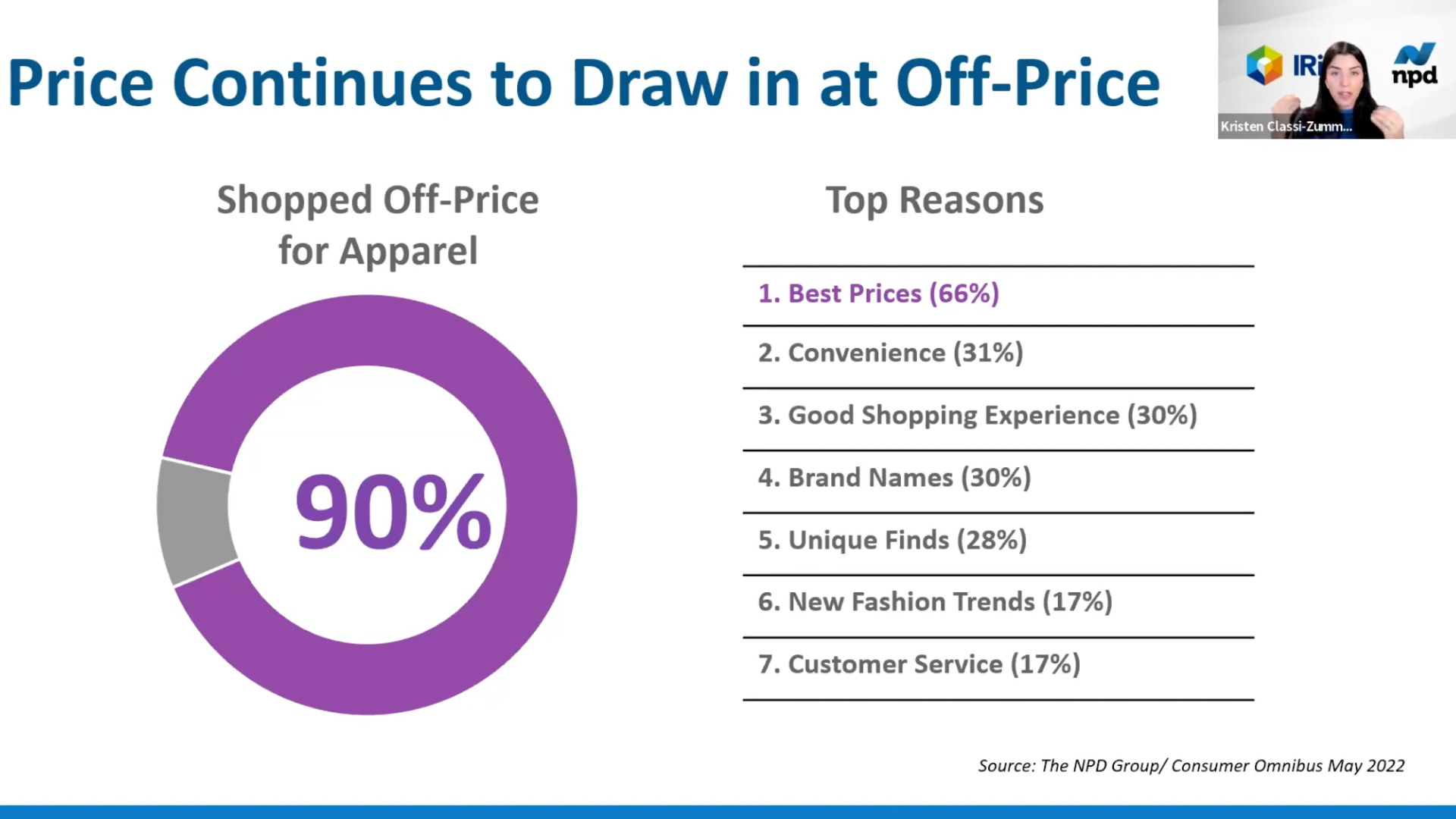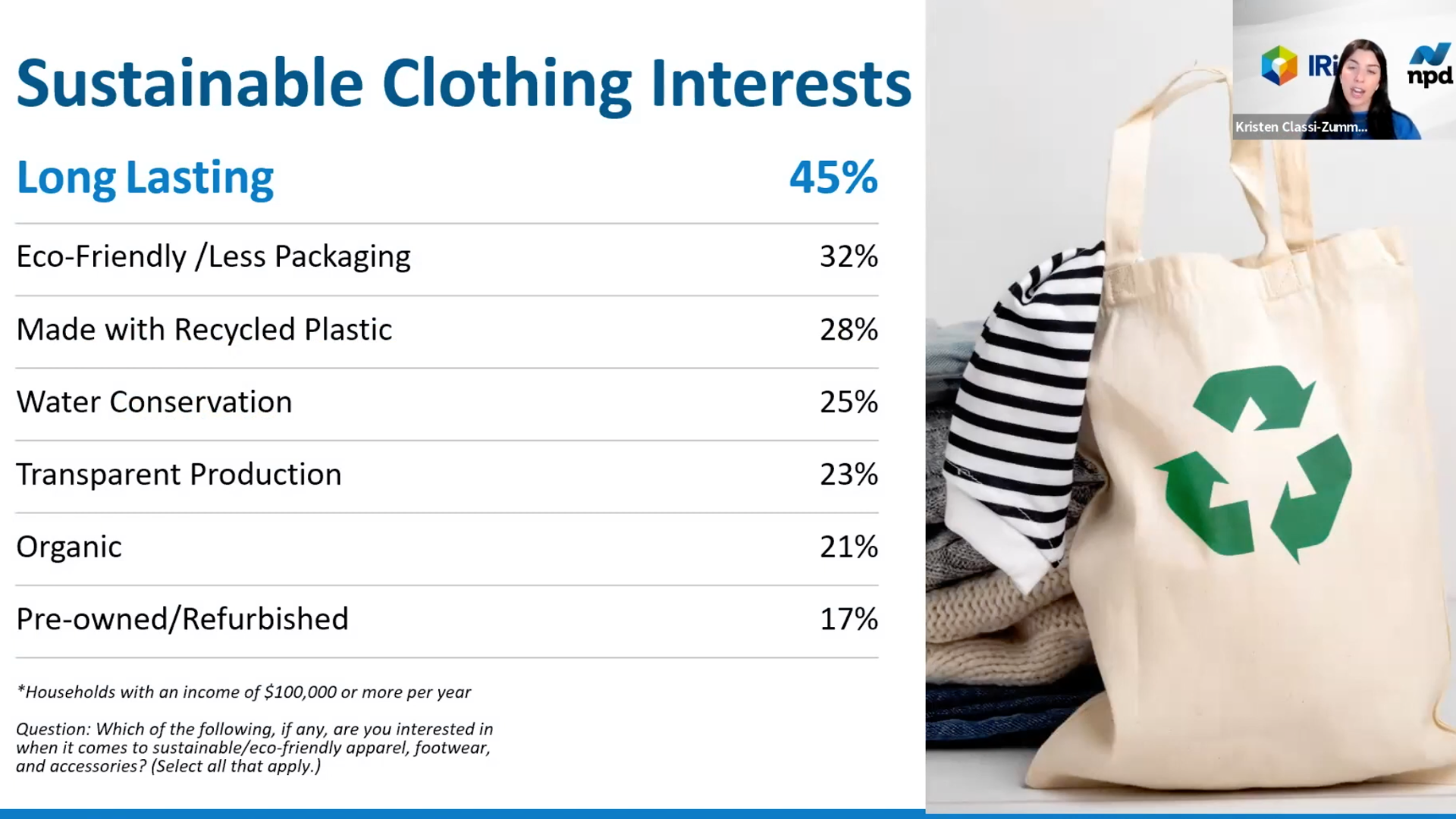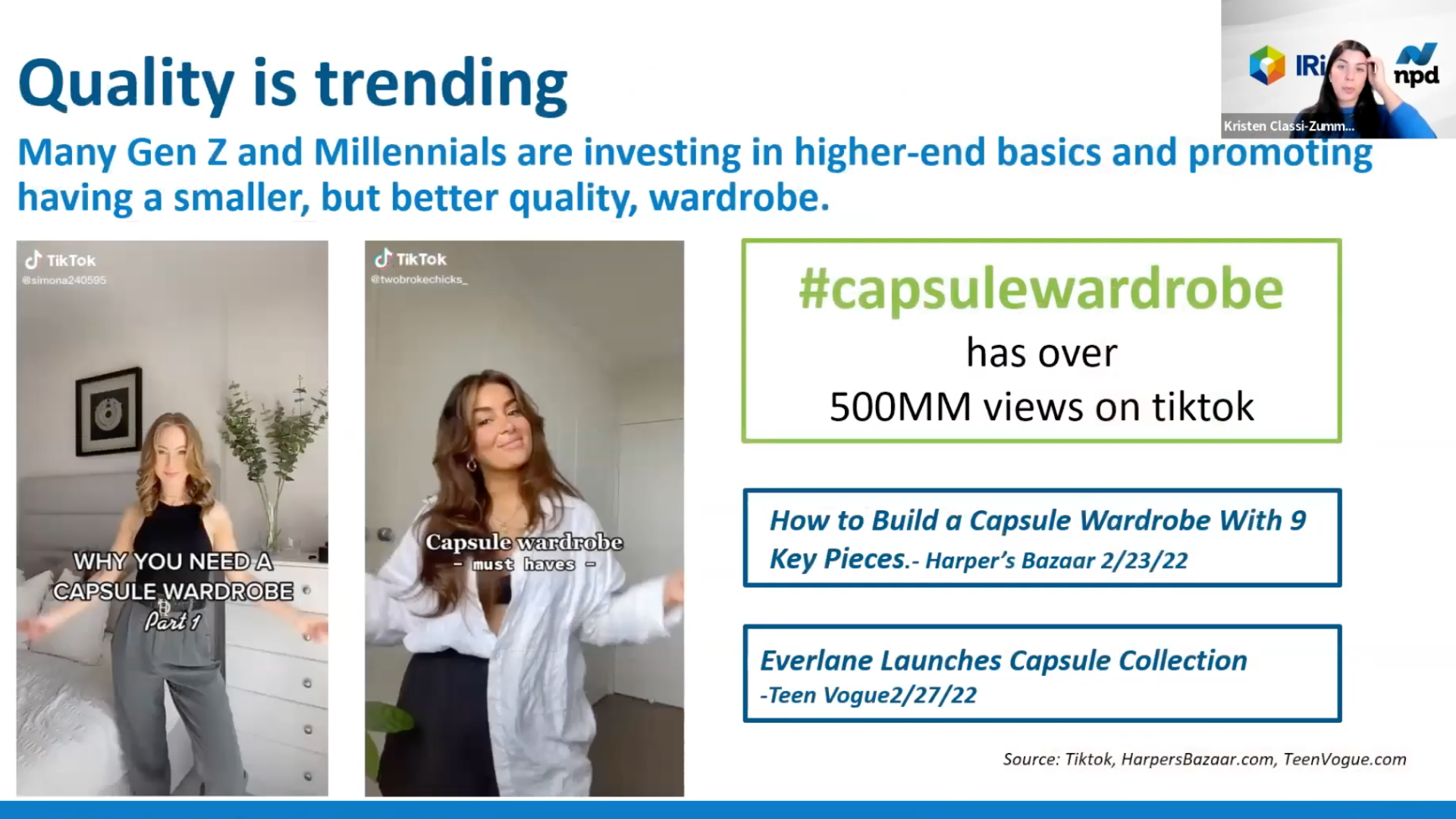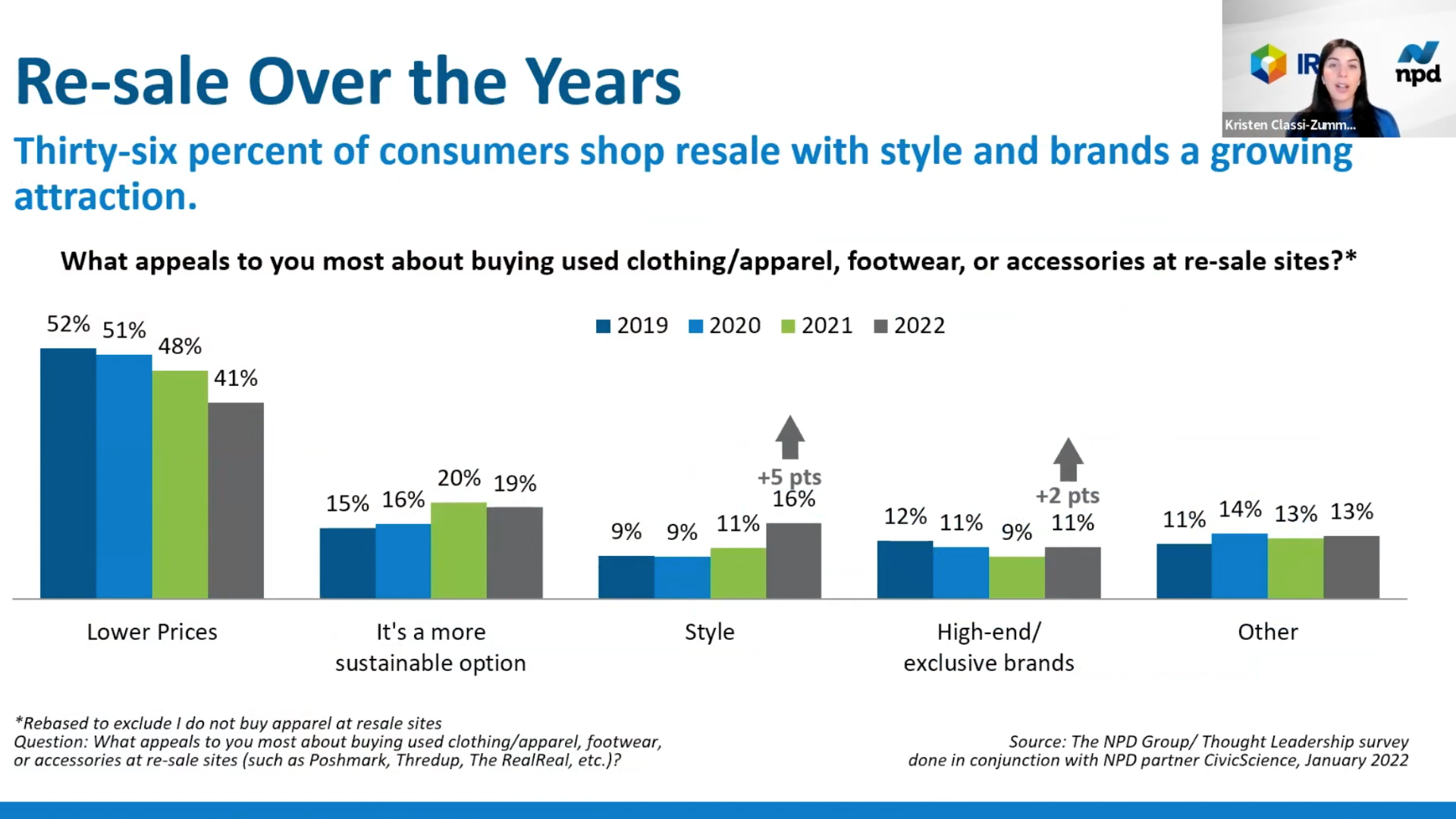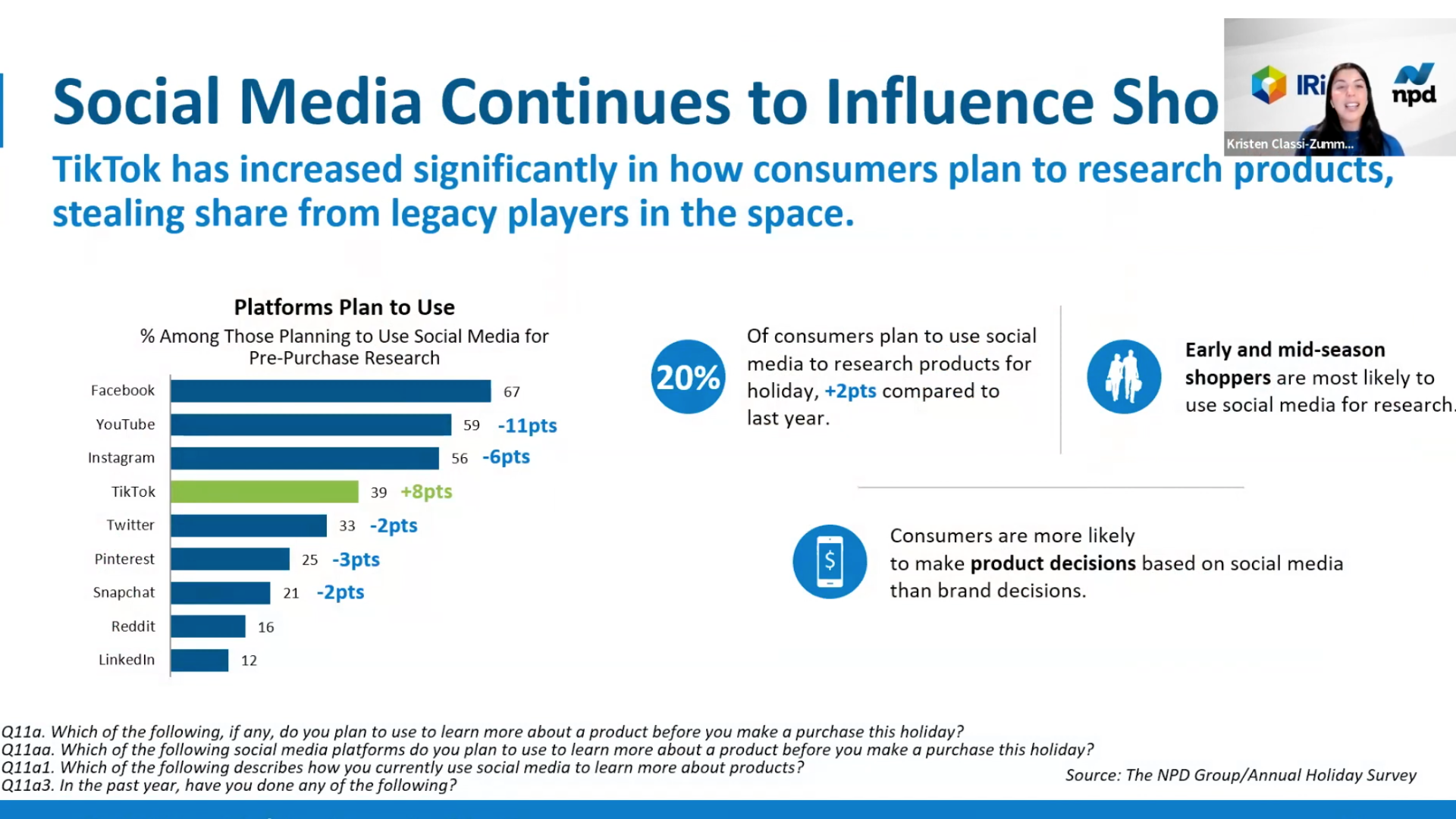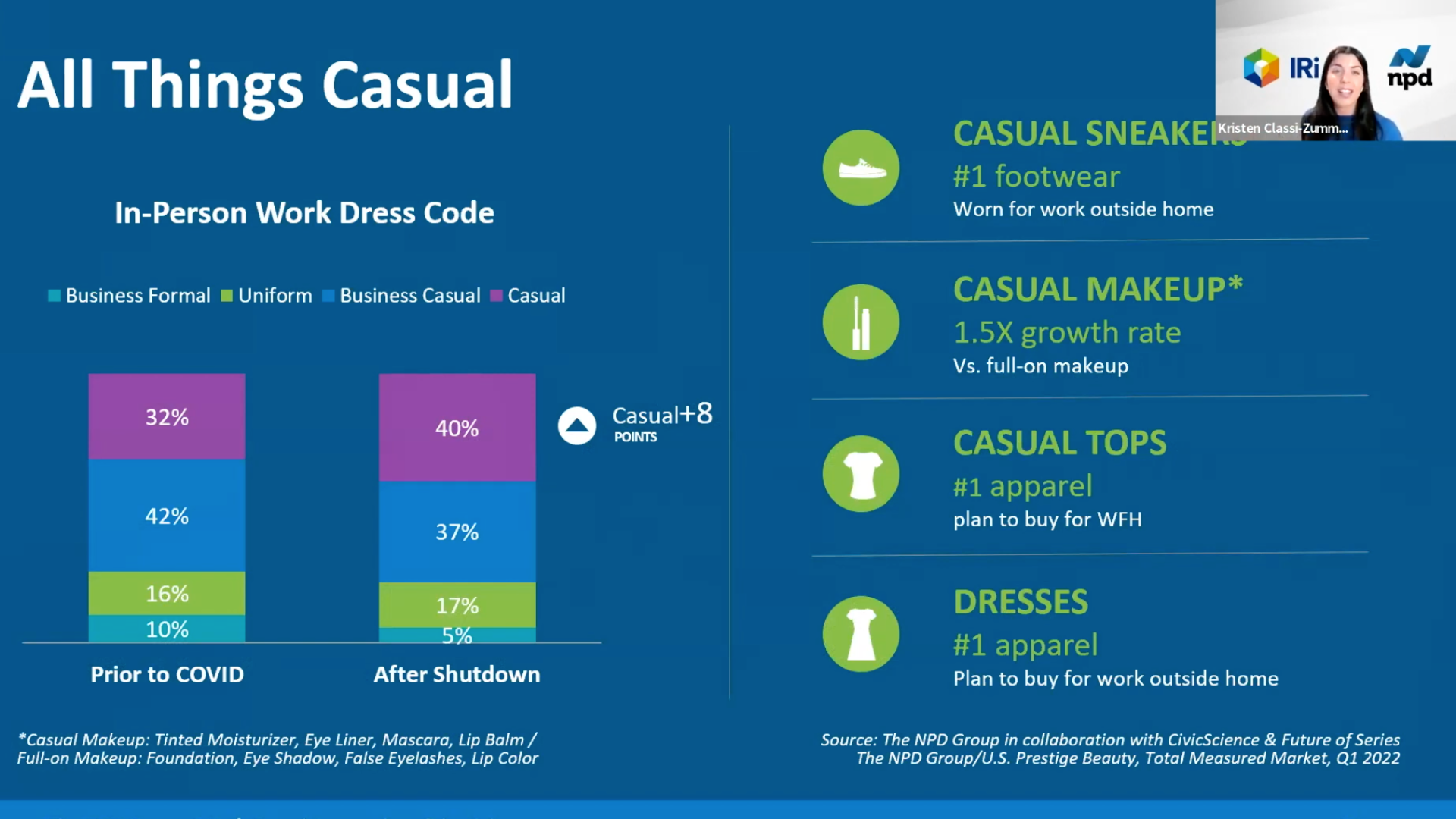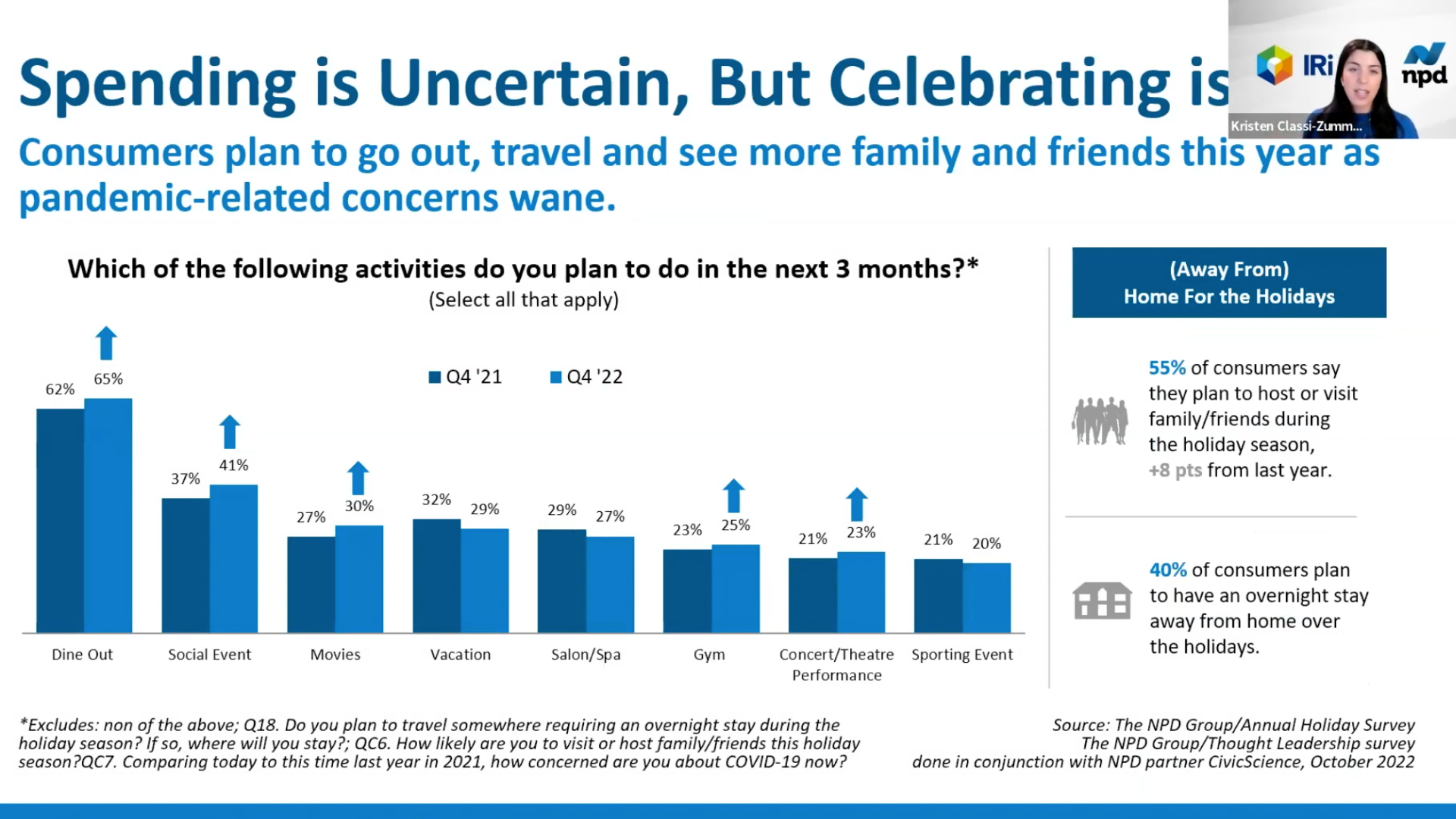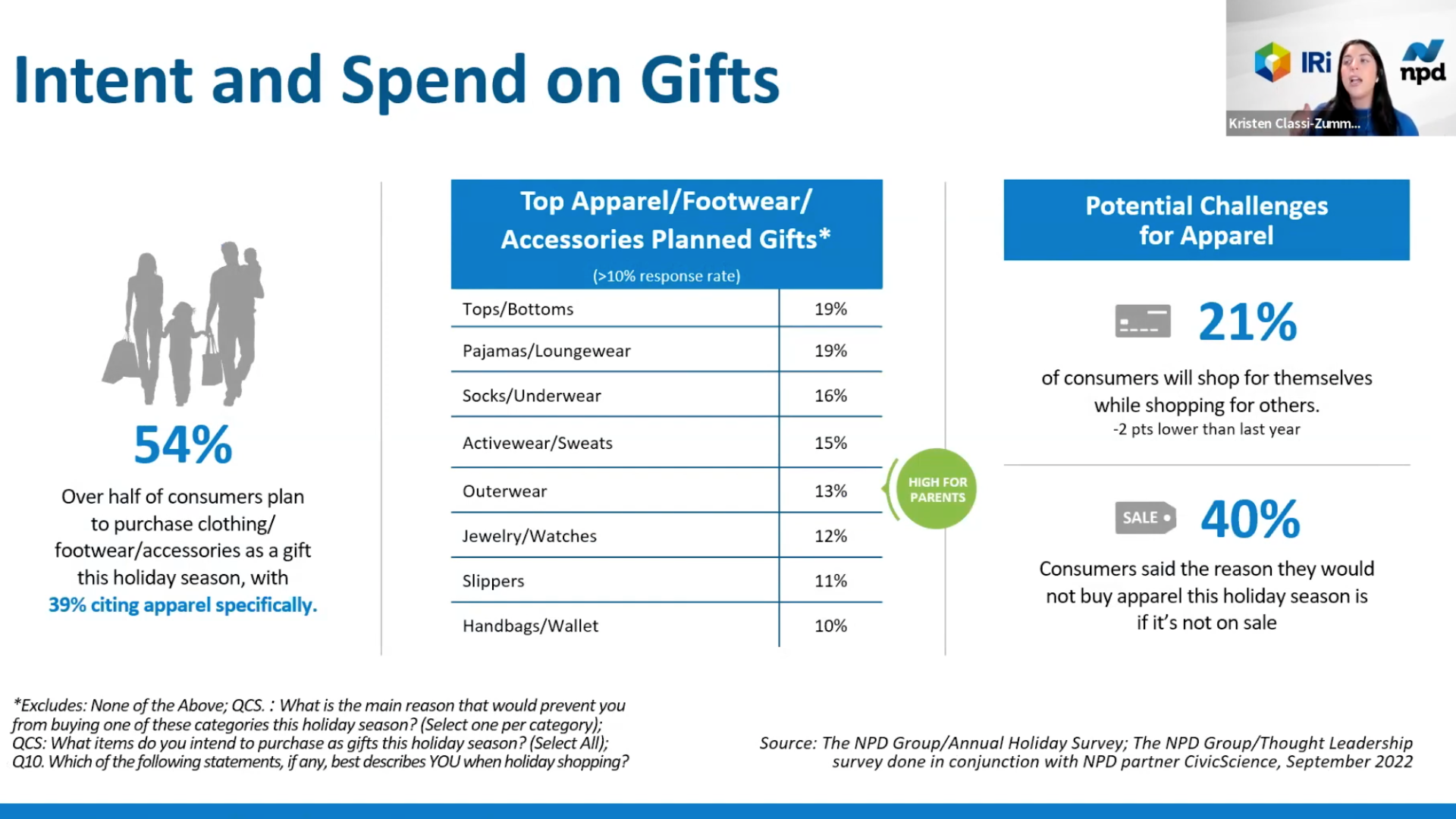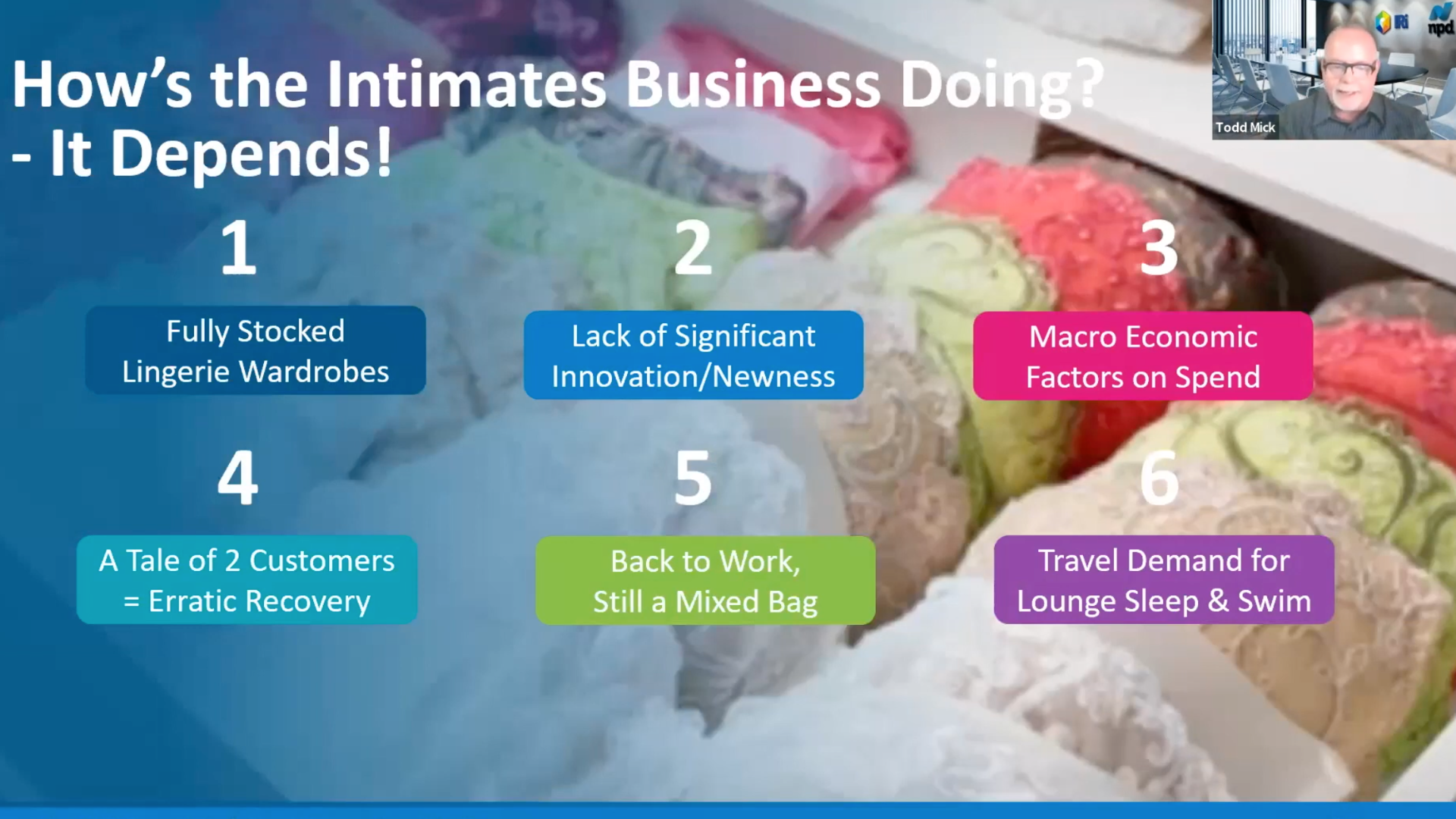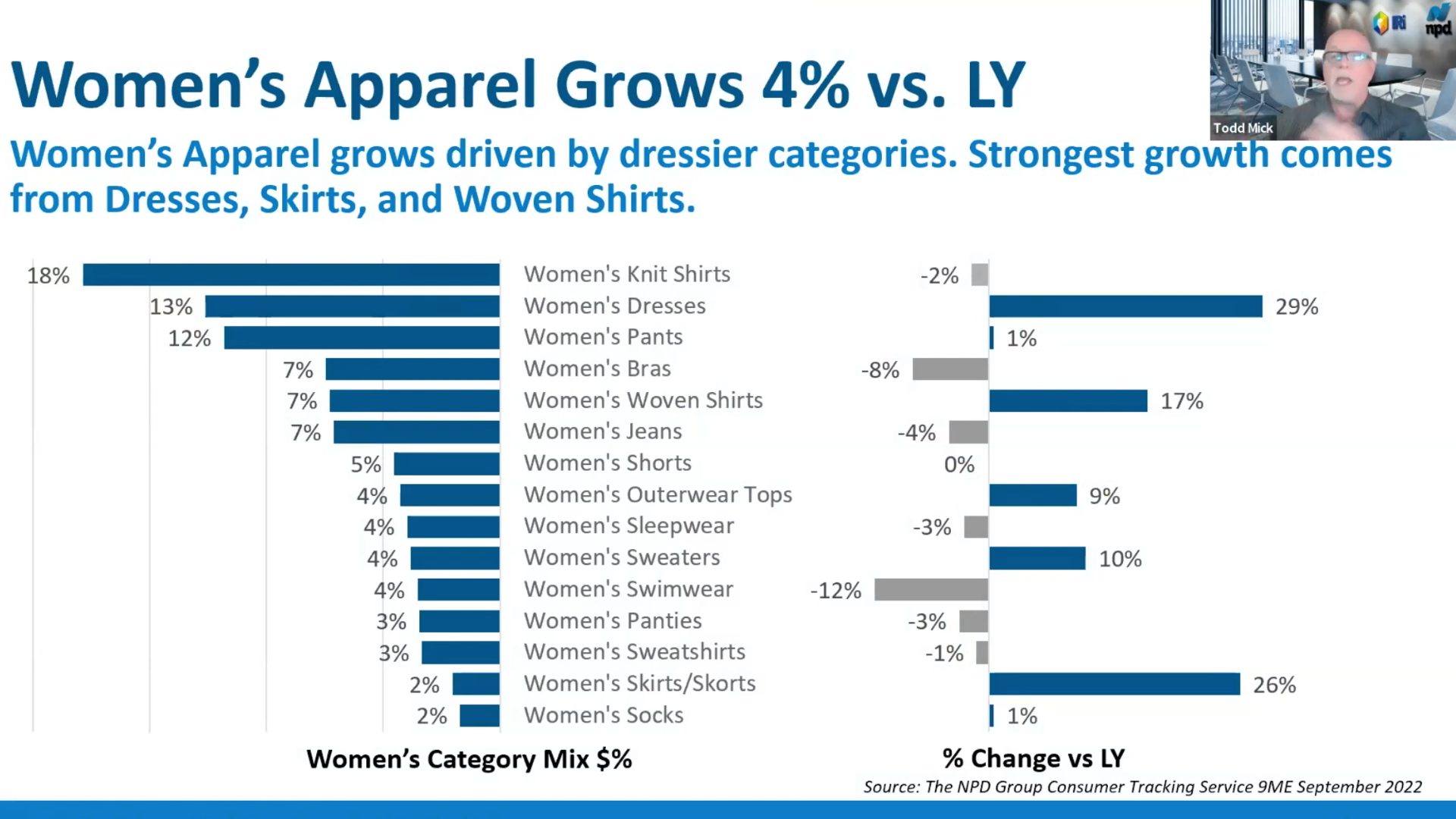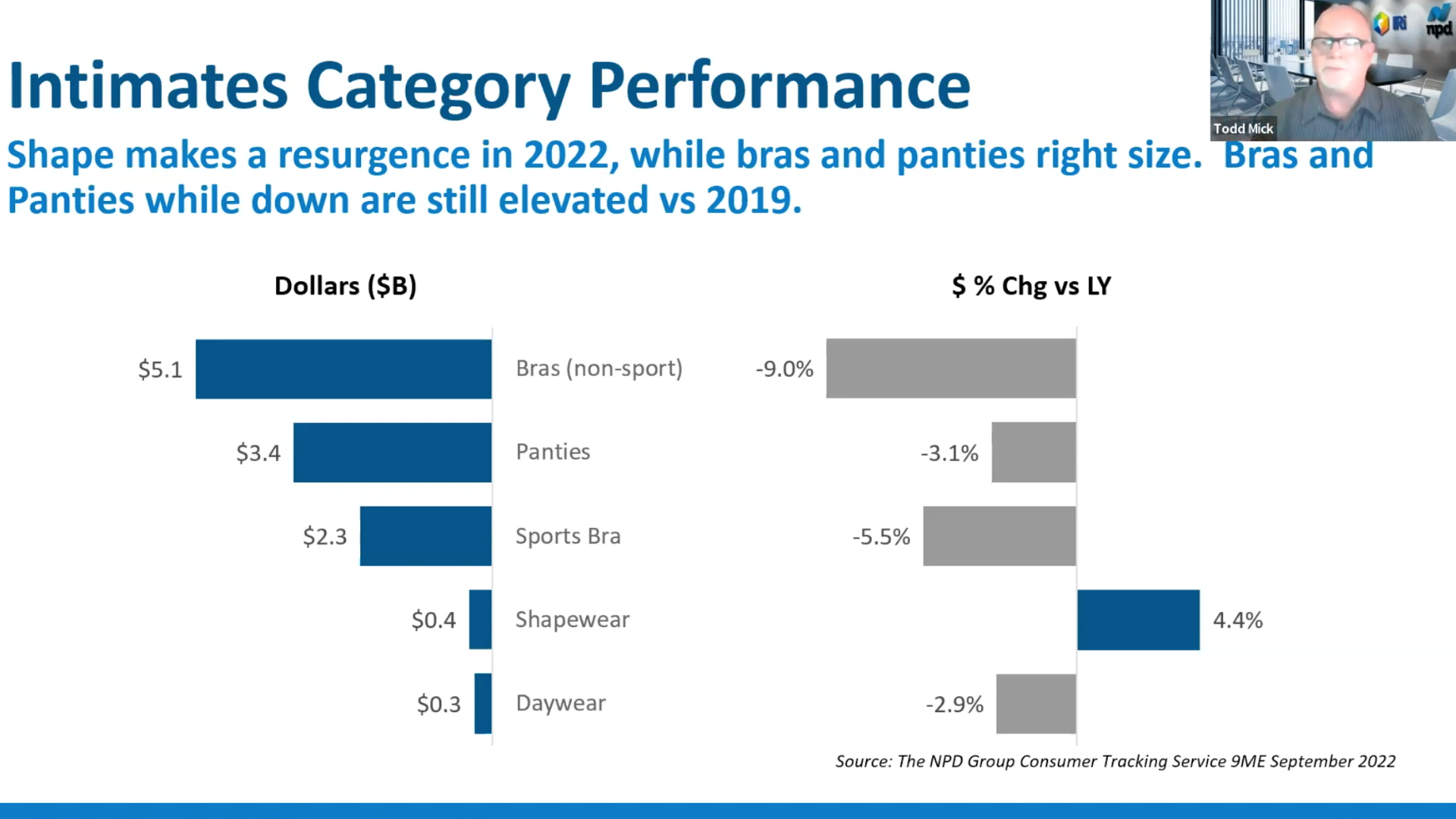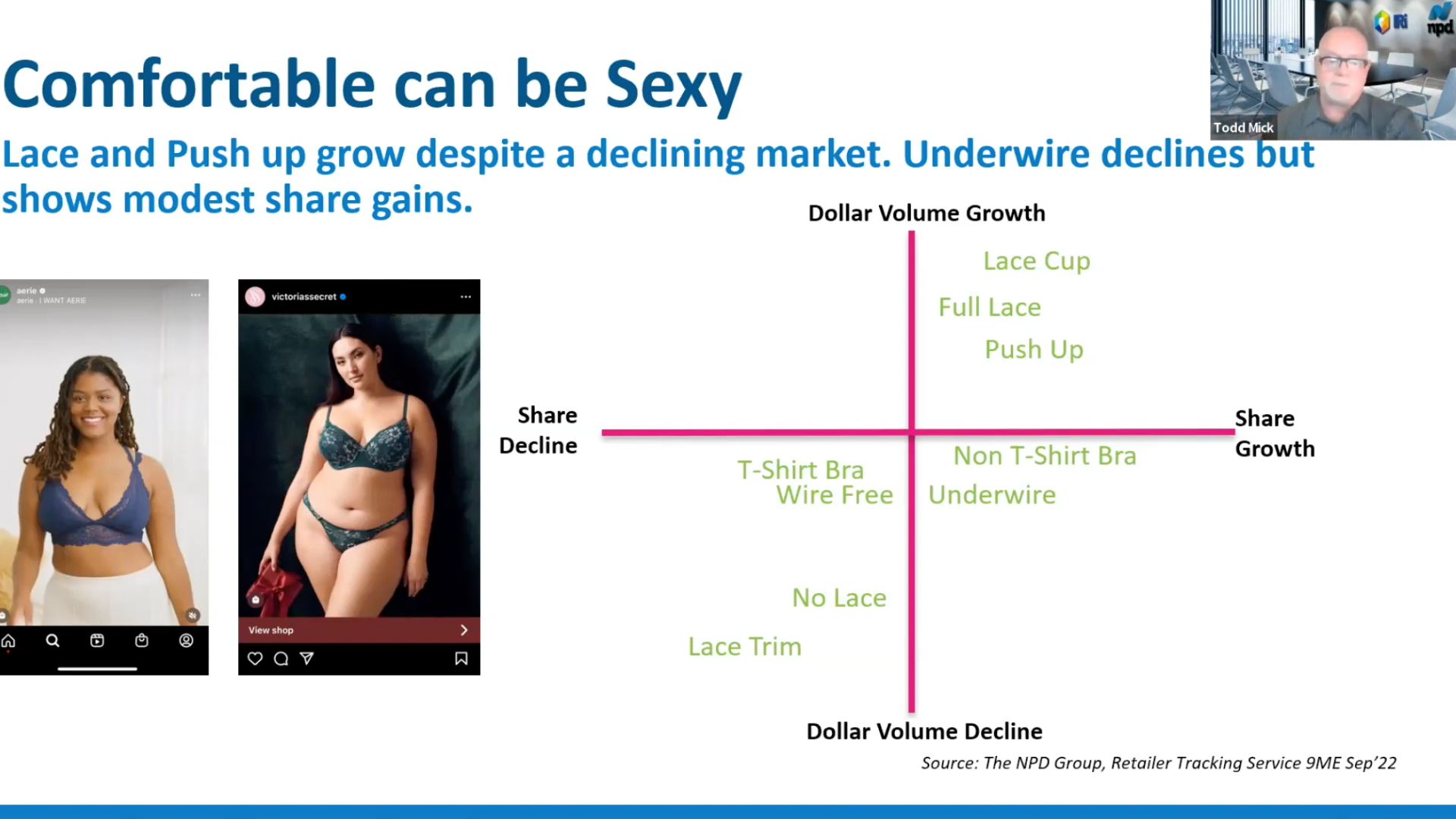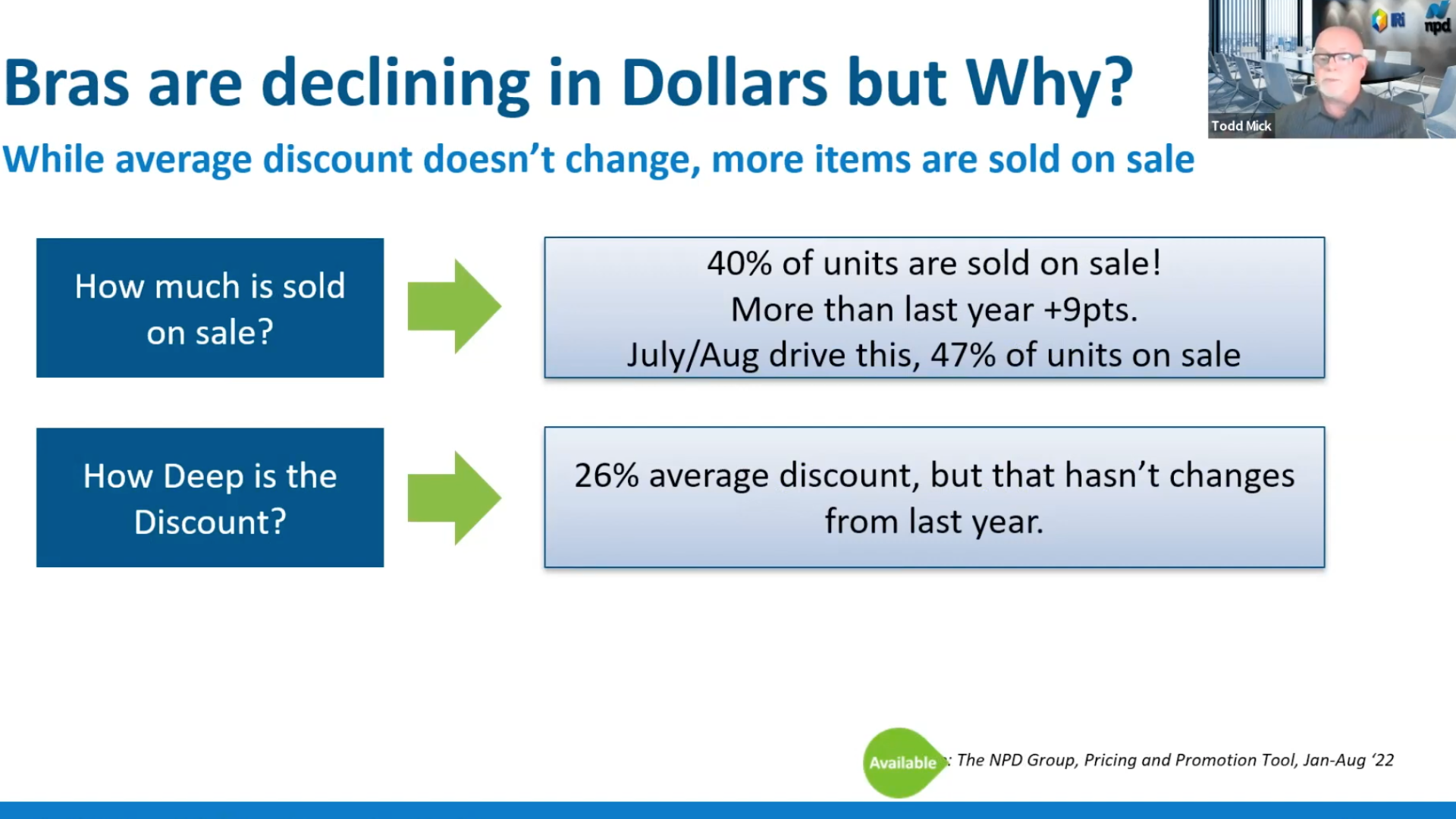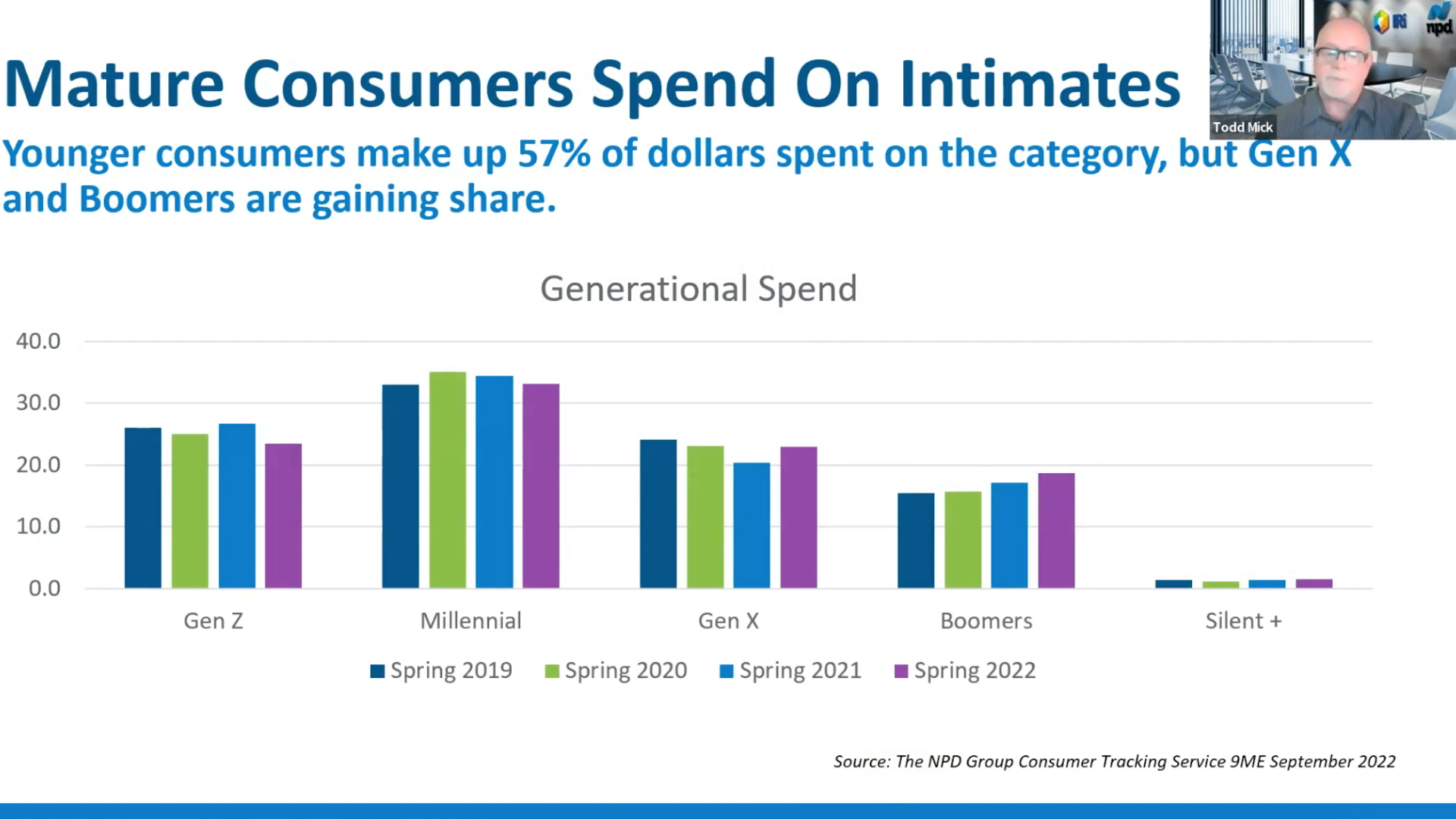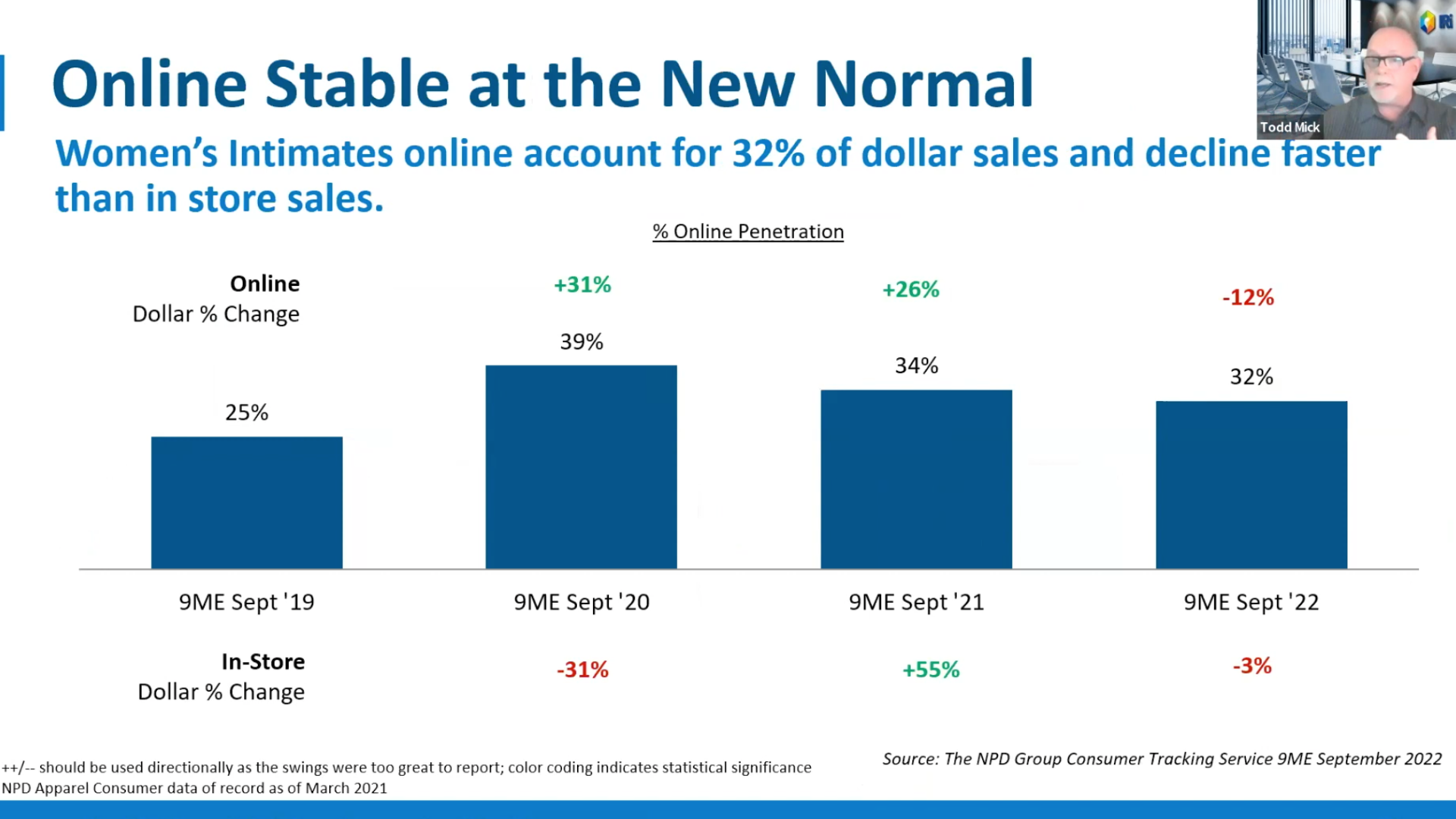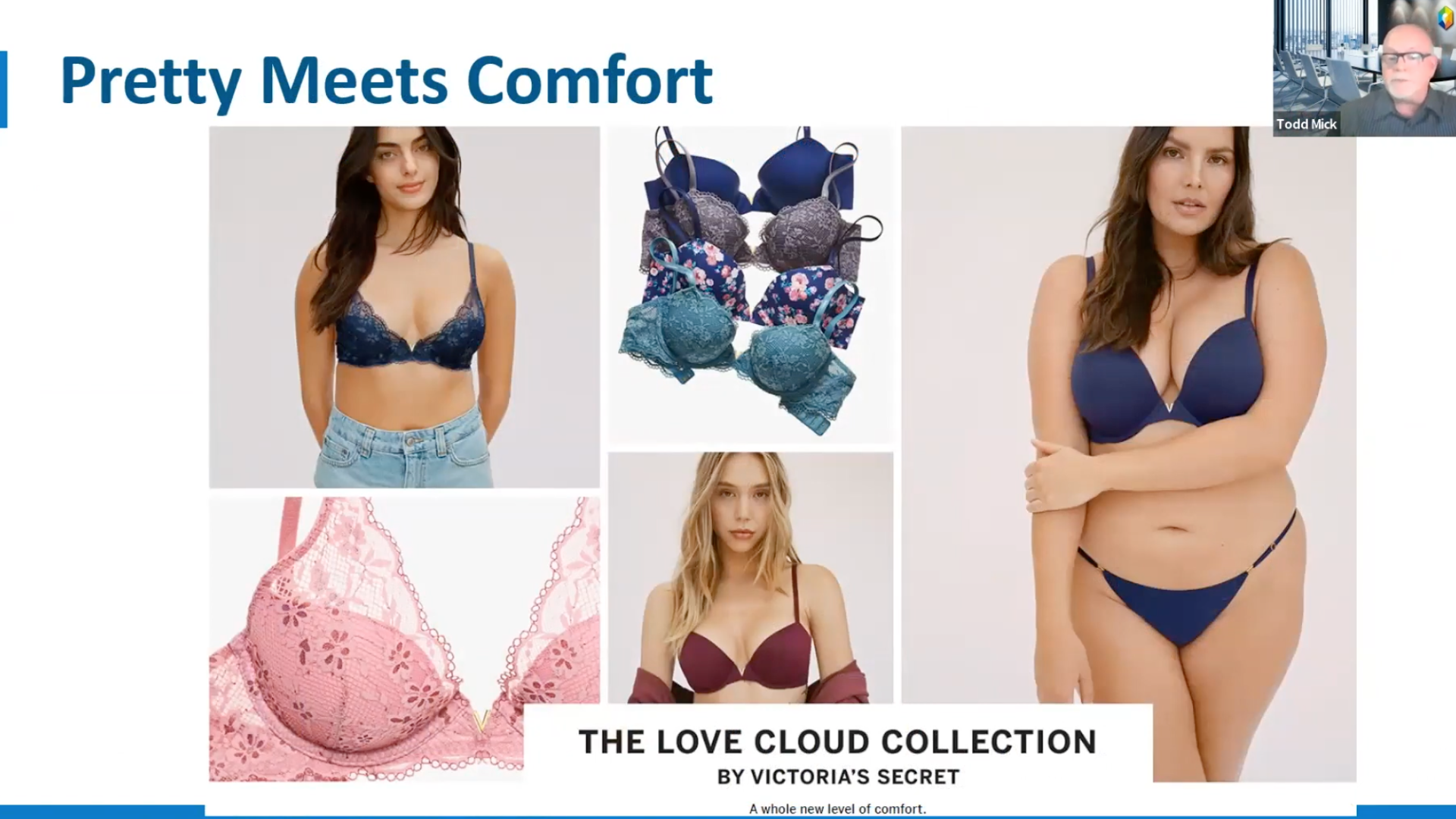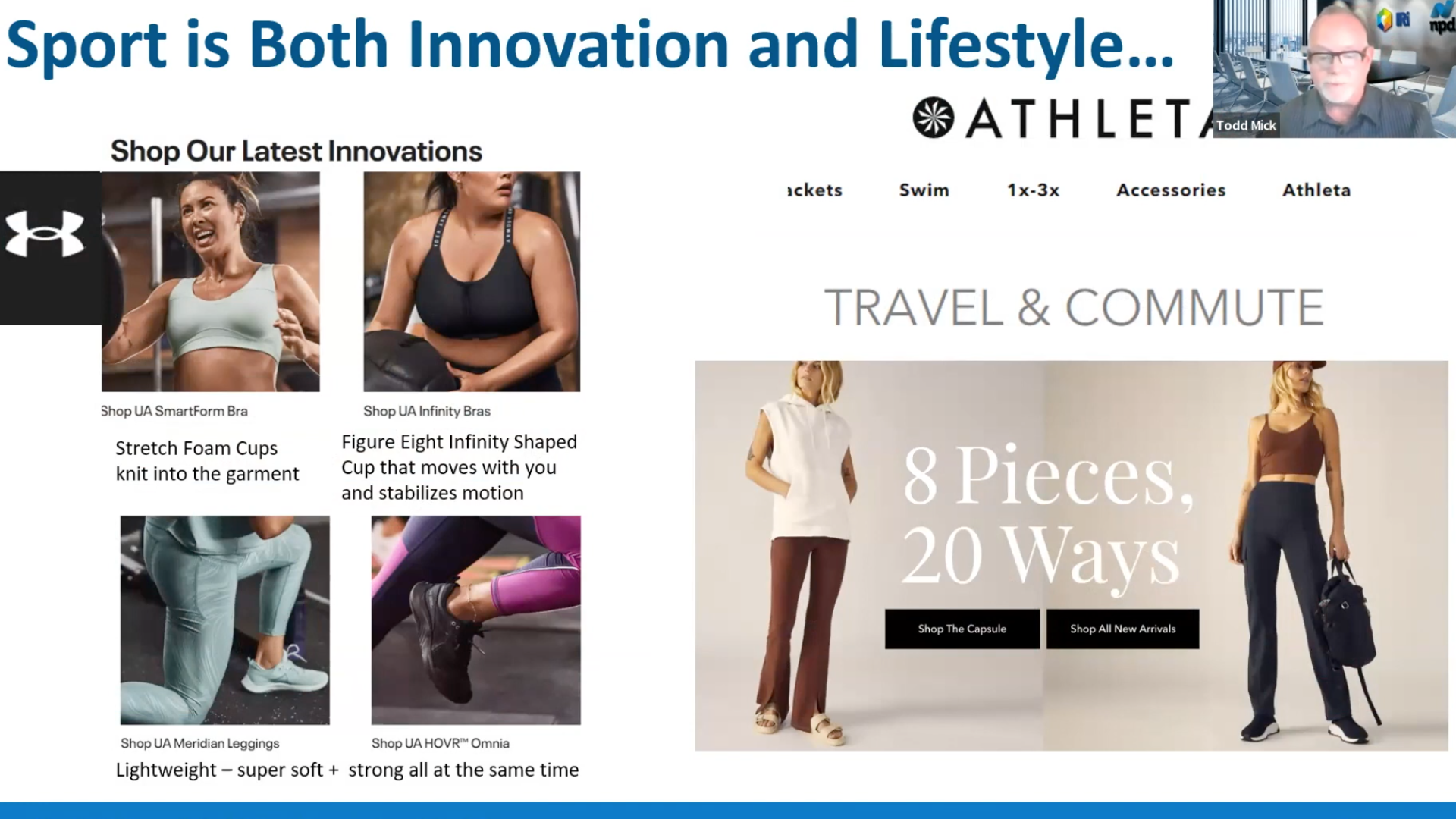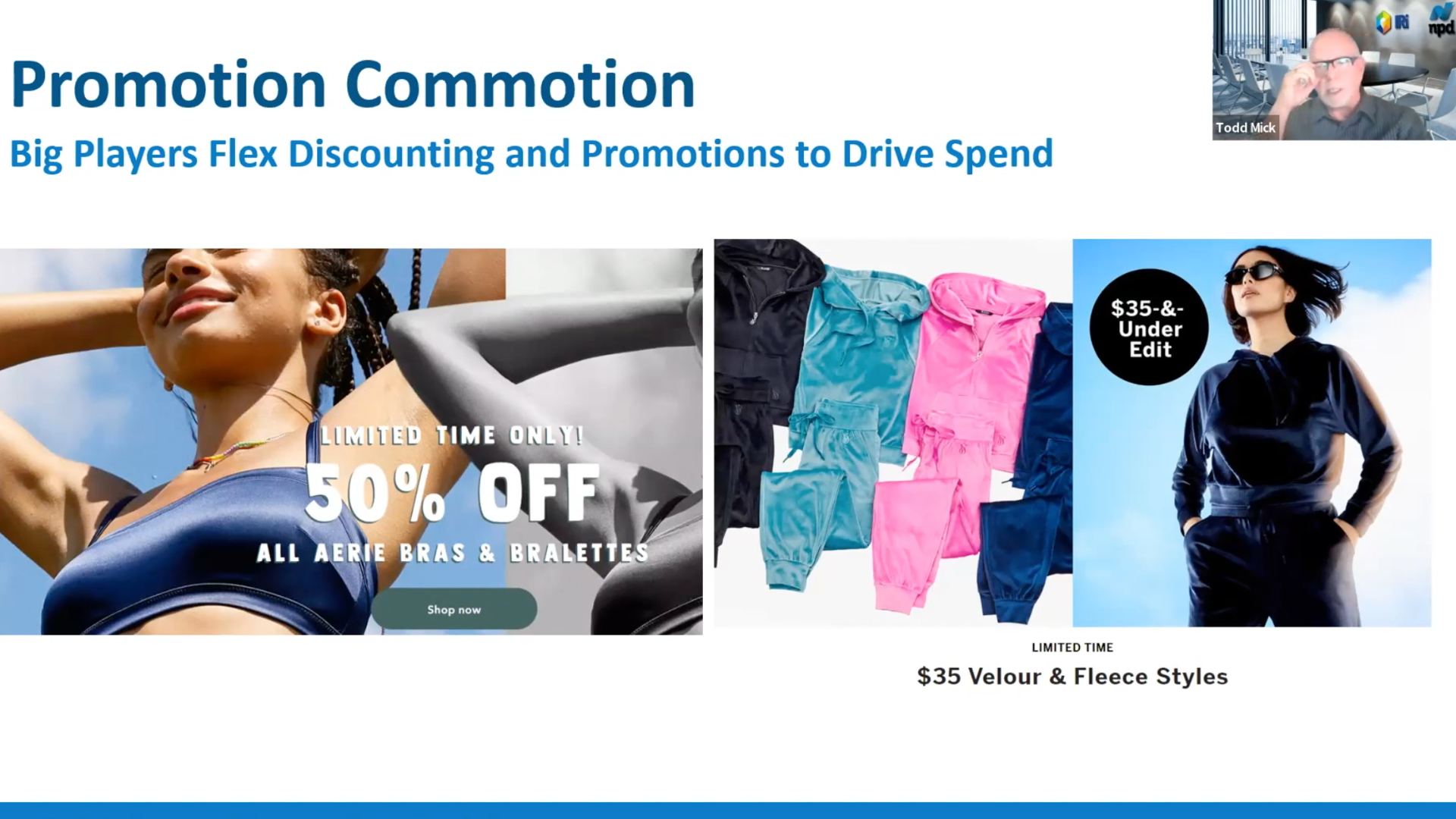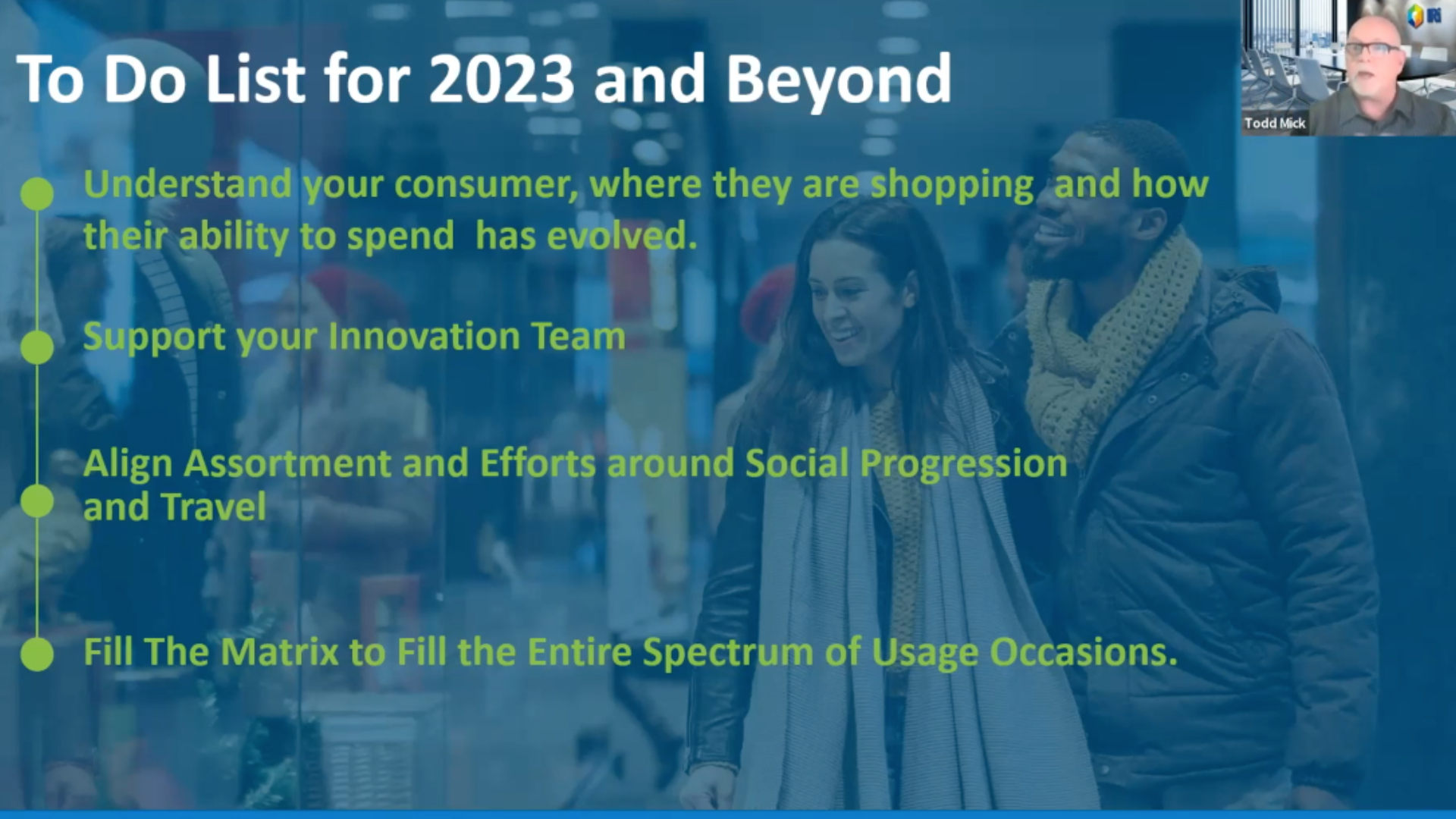We had the pleasure of learning about how the 2022 Apparel and Innerwear Market has been performing, with insight into the future with NPD industry analysts, Todd Mick and Kristen Classi-Zummo! They shared the exciting news that NPD is merging with IRI and will be launching under a new name in January 2023! This will give them a more complete view of consumer’s spending habits and needs, facilitating the analysis of even more reliable information for business forecasting. Congratulations and thank you Kristen and Todd for sharing your time and knowledge with us!
Similarly to the onset of the pandemic, recent consumer behavior has become erratic and hard to predict. Today’s consumer landscape is largely influenced by several factors that serve as a guiding light to help in predicting how consumers will spend on apparel. The cost of living is increasing as essentials such as rent/mortgage, gas, and food are costing us all more. Although some things have become more expensive, we aren’t giving up on little luxuries and experiential spending. Inventory is building up in all categories of apparel, from basics to activewear, which is leading to more promotions. Most importantly for the end of 2022, the upcoming holidays will drive spending on celebration and travel. All of this ties into how the apparel and intimates industries are performing.
Apparel has been maintaining its momentum and remaining flat through Q2 and Q3 of 2022. This signifies pull-back in terms of demand, with higher average selling prices keeping the dollar percentages stable. A new level has been set in terms of spend, with dollars being higher than they were in 2019. This means that despite the recent lull in activity, dollars being spent in 2022 are still above average.
Due to inflation, 81% of consumers stated that they already have or are planning to cut back on spending. The top category to feel this will be restaurant dining, reported by 66% of those who plan to spend less. The second category to feel this pull-back is apparel, with 48% planning to spend less on clothing. Apparel is one of the top categories where consumers seek out promotions, presenting a great opportunity for retailers to plan accordingly.
Over two-thirds of consumers plan to shift where they shop as a result of inflation, with 41% moving to purchase less expensive brands. Rising prices in many fashion industries caused growth in spend per buyer while purchase frequency declined. To drive sales, it is key to capture the buyer’s attention while they’re in-store. Seek to make a strong impression during their one-stop-shopping session, especially during the holiday season. People are still looking for brand names, but at affordable prices.
Since the consumer can’t spend much, the little luxuries in life have become that much more important to them. Attainable luxury is currently in demand, and our industry falls within these parameters! Lingerie is a little luxury that boosts confidence and gives the sense of indulgence people are looking for.
People are buying less and better-quality clothing to promote green and sustainable options. It’s the top choice regarding sustainability in fashion, beating out other eco-friendly efforts like minimal packaging, recycled materials, water conservation, organic and more. Consumers of all age groups want quality, long-lasting apparel.
Supporting this is the #capsulewardrobe trend on social media, where people are sharing their high-quality yet minimal collection of clothing. This hashtag has over half a billion views on TikTok, where Gen Z and Millennial influencers are promoting high-end basics and smaller wardrobes.
Resale is also big, with over a third of today’s consumers shopping for used apparel. Lower prices and sustainability are the main motivators for shopping in this category, but 2022 has seen an uptick in people doing it to look for trending styles and high-end/exclusive brands. More brands are seeing this and expanding retail partnerships and programs to offer resale programs that are helping them grow. Third-party sites have seen increased orders in the double digits in Q2, showing positive earnings by being in this growing category.
Social media plays a significant role in what people are buying, especially for Gen Z. TikTok is massively influential, with teens spending more than 90 minutes a day on the platform. Since June, it’s become the #1 platform for kids and teens, beating YouTube. This platform of short video clips is being used for brand discovery and shopping in many different industries. With it, people are finding out about brands and trends faster than ever before. Social selling will be affecting what people shop for this holiday season, with 1 in 5 consumers saying they will be using social media to research products.
People are also socializing more in-person! Employees are returning to the office, with a 10-city average showing offices are at a 47% occupancy rate. In-person work dress code is relevant again, though it is definitely getting more casual. 8% more offices have casual dress codes than they did pre-pandemic. Sneakers and dresses are often being worn to work outside of the home.
78% of people are planning to go on vacation within the next year, and over half of them are doing it within the next 3 months. Though people are cutting back on spending, they’re still planning on going out and celebrating! 40% of people are planning on having an overnight stay, presenting a great opportunity for sleepwear. Consumers plan to dress up, head out, and host events for the holidays.
Over half of consumers are thinking of gifting apparel this holiday season. Tops and bottoms as well as pajamas and loungewear are the top apparel gift ideas, with socks and underwear close behind. Cozy-wear will be a popular holiday gift this season. 21% of consumers will shop for themselves while shopping for others. 40% won’t buy apparel if it’s not on sale. It’s anticipated that apparel in Q4 will be flat if not slightly down in terms of dollars with less items being sold at higher average selling prices.
So, how’s the intimates business in particular doing? In 2022 and 2023, it depends on several market factors that influence the uncertainty. Spending priorities are changing in the apparel space and beyond. The post-pandemic consumer has already done a lot of innerwear shopping and have fully stocked lingerie wardrobes. Also, there haven’t been many new innovations since the bralette to motivate new intimates purchases. Macro economic factors and the higher cost of living also affect discretionary spending. Spending varies by income level, with affluent consumers spending with momentum that’s expected to continue into 2023. Back to work is a mixed bag since most people are not going back to work as quickly as expected. Travel plans are inspiring demand for lounge and sleep for smoothing and comfort. Swimwear is expected to thrive in 2023 with consumers needing to replenish this category after buying their last piece two years ago. There’s also high growth in branded shapewear.
The roller coaster continues on. Given that we had next-level growth in the past two years, we’re still up 15% since 2019 and only 6% down from 2021. Total women’s wear is up 4% from last year as social progression continues and the less homebound life evolves. Current growth categories in fashion are outerwear. Basics categories that were so strong during the pandemic are resetting to normalized demand patterns. The intimates industry has grown by $2.9B since 2019, including the sleep category.
Brands in 2022 are bringing in young, colorful, fresh faces for the next generation. Period panties are being brought to the masses. Many intimates brands are expanding into other categories such as shapewear, activewear, and acquiring other companies to offer a wider variety of goods and services.
In the core intimates categories, shapewear is the only one to see growth this year due to people planning to go out more, and is up 4%. Panties have seen the least negative impact as they’re replenished most often. Non-sport bras are not selling so well this year, but the underwire bra is still relevant.
Despite declining sales, pushup and lace bras are growing faster than the market and gaining market share. This data dispels the myth that underwires are no longer wanted by consumers. Comfort and style are merging as the consumer shops for intimates that make her feel put-together while not sacrificing the comfort embraced during the pandemic.
Bras are declining in sales. While the average discount isn’t changing from 26%, 40% of bras are being purchased while they’re on sale. That’s 9% more than last year. The intimates clearance month bumped this figure up to 47%.
It’s important to know your customer. Gen Z and Millennials make up the majority of the intimates market at 57%. However, it’s Gen X and Boomers that are driving growth in the intimates space. The evidence is seen in department stores and designer brands having a better year in 2022 than they did last year.
Online sales in intimates account for 32% of dollar sales in 2022. It’s on a decline that’s faster than in-store sales, as malls are still in. The digital darlings, Gen Z and Millennials prefer to shop in-person in order to touch, feel, and socialize. Where shoppers shop depends largely on their age.
The latest trend in bras is the merging of comfort with pretty and sexy in new styles. The date night push-up bra is back as an “everywhere” bra. There are soft-constructed push-up bralettes and more tradition foam T-shirt push-up bras, meant to be worn for all occasions.
Larger players in the space are filling in their merchandising matrix to serve a broader and more inclusive audience. An athletic brand released sports bras with innovative stretch foam cups to increase versatility. Other brands are expanding on athleisure, releasing pieces that are meant to be worn at all places to fill in the consumer’s total wardrobe.
Retailers and brands are getting more promotional. Discounts are being held beyond semi-annual sales to clear out inventory space that’s bringing in products faster than they can sell them. Fortunately, the innerwear business has a much larger proportion of seasonal basics and replenishment inventory, making it easier to manage and correct moving forward.
2022 has been a roller coaster that is expanding to 2023, but there’s great advice to keep your business in good standing. Being customer-centric is a strategy that’s timeless and always effective. Understanding your customer and the other brands they’re interested in will help planning for the future. Also, this industry is full of smart and creative people! Support your teams to help bring the best innovations to the marketplace. Basics maintain volume but innovation drives growth. Align your assortment and efforts with social progression and travel to match evolving lifestyles and needs to drive incremental sales throughout the entire merchandise mix. Last but not least, Fill The Matrix! This is a term coined by IRI, used to refer to the creation of products that meet the full spectrum of usage occasions. In innerwear, garments that provide comfort, smoothing, lift, and prettiness are the winning strategy.
After many peaks and plateaus in the past 3 years, we expect to see things level off in the next year. Closets are quite full now, so we need to fill the matrix and serve all the niches consumers need going forward. Consumers are tightening discretionary spending, making it key to focus on trends, innovation and newness in order to drive sales. Without trends, there’s no motivation for newness as the consumer can get by with what she has. Keep in mind that today’s consumer is investing in her shapewear!
Our thanks to Todd Mick and Kristen Classi-Zummo for sharing their thoughtful insight with us! It’s always an enlightening presentation.
If you’re an Underfashion Club member, sign in to watch the full webinar on YouTube below!
